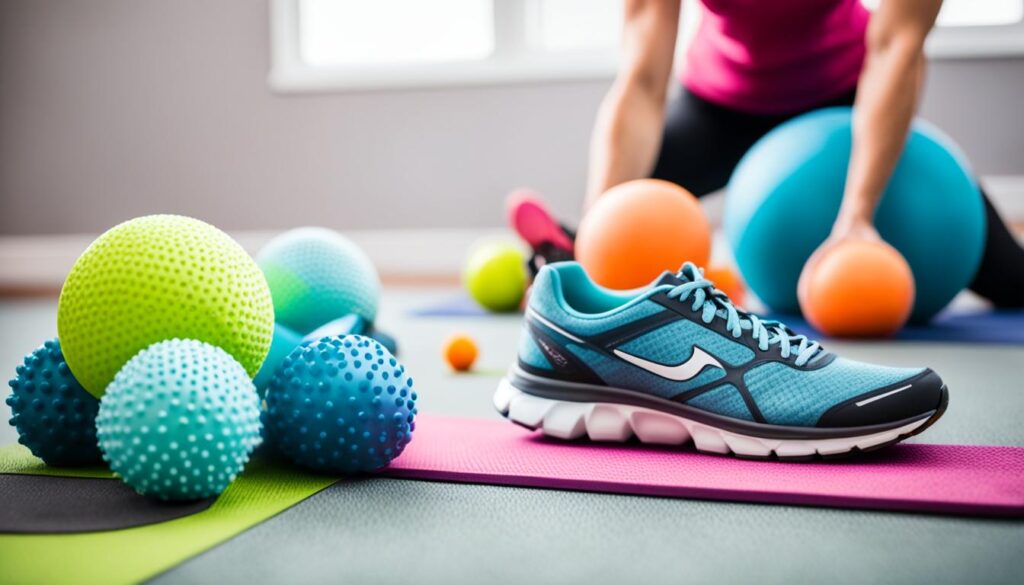Did you know recovery can boost a runner’s performance by up to 30%? For master runners, focusing on recovery is vital. It’s not just advice; it’s a must as our bodies age. Well-planned recovery strategies keep performance high and overtraining at bay.
For master runners, adding easy runs is key. These runs promote active recovery while keeping your heart healthy. This approach links recovery to better performance as muscles repair and get stronger.
Forget static stretches; dynamic warm-ups are better for older runners. These exercises increase blood flow and prepare your body before running. Tailoring these warm-ups to your run’s intensity helps with faster recovery afterward.
Recovering isn’t just physical. It includes eating right, sleeping well, and taking days off. Good nutrition fuels body repair, and sleep is crucial for muscle recovery. These elements help runners safely push their limits.
Key Takeaways
- Balancing training and recovery is crucial for master runners to maintain performance and avoid overtraining.
- Easy runs aid in active recovery and support overall cardiovascular health.
- Dynamic warm-ups effectively prepare muscles for exertion, minimizing potential damage.
- A comprehensive recovery plan includes proper nutrition, sleep, and designated recovery days.
- Recovery directly links to performance improvement through muscle repair and adaptation.
Importance of Recovery for Master Runners
For master runners, a solid recovery plan is key. Recovery isn’t just down time; it’s when you improve. This is crucial because as we age, our bodies heal differently. Through comprehensive recovery, athletes can enhance their performance and dodge injuries.
Ignoring recovery boosts the chance of training too much. Master athletes must customize their recovery to fit their needs. By doing this, they keep healthy and perform at their best.
To get the most from recovery, you need good food, enough sleep, and proper rest days. These parts are crucial for a balanced recovery strategy. They ensure older athletes meet their specific needs.
Putting focus on recovery is essential, not just an add-on. Using detailed recovery tips can keep athletes at the top of their game longer. It ensures a lengthy and healthy time running.
Dynamic Warm-ups Before Running
Dynamic warm-ups are key for an advanced runner’s recovery plan. They get muscles ready and reduce injury chances. Unlike static stretches, these exercises up your heart rate and blood flow. This is super important for seasoned runners.
Benefits of Dynamic Warm-ups
Dynamic warm-ups bring a lot of good to a runner’s recovery plan. Here’s how they help:
- Enhance muscle activation
- Increase the range of motion
- Boost overall performance
- Reduce the risk of injuries
- Prepare the cardiovascular system for running
Sample Dynamic Warm-up Exercises
Adding certain exercises to your warm-up routine is valuable. Here are some top dynamic warm-ups for runners:
| Exercise | Description |
|---|---|
| Leg Swings | Stand and swing one leg forward and backward, switching legs each time. |
| High Knees | Run in place, bringing your knees up as high as you can. |
| Butt Kicks | Run in place, trying to hit your buttocks with your heels. |
| Arm Circles | Stretch your arms out and make circles, starting small and getting bigger. |
| Hip Circles | Stand and rotate your hips in circles, keeping your feet hip-width apart. |
These dynamic warm-up exercises get you ready to run well and recover better. Remember, doing warm-ups right and often is crucial for any serious runner.
Recovery Strategies for the Master Runner
Effective recovery strategies can boost a master runner’s performance and lower the chance of injury. Mixing advanced and traditional recovery methods is key. This offers a quick look at top recovery tips for runners.

Post-Run Cool Down Techniques
A good cool-down is vital for starting recovery. Easy miles after a hard run reduce muscle stiffness and clear out toxins. Light jogging or walking for 10-15 minutes helps lower your heart rate safely, preventing dizziness.
Dynamic Compression Boots
Dynamic compression boots are a hit with experienced runners. They boost blood flow, lessen muscle weariness, and speed up muscle healing. Offered at numerous recovery studios, they let runners relax while receiving rhythmic compression therapy.
Massage Therapy
Massage therapy is a key recovery tool. It enhances blood circulation, boosts oxygen to muscles, and lowers inflammation. At-home tools like foam rollers and massage guns are great. They break down scar tissue, ease muscle tightness, and improve flexibility.
| Recovery Technique | Benefits |
|---|---|
| Post-Run Cool Down | Reduces stiffness, flushes out waste, stabilizes heart rate |
| Dynamic Compression Boots | Enhances circulation, reduces fatigue, expedites muscle repair |
| Massage Therapy | Improves blood flow, reduces inflammation, increases flexibility |
Adding these recovery tactics benefits a master runner by speeding up recovery, improving performance, and building resilience. Following these best practices for recovery helps athletes extend their careers and have healthier runs.
Incorporating Nutrition into Recovery
Nutrition plays a huge role in recovery, especially for master runners. They need to focus on what they eat to heal after running. It’s crucial to choose the right foods and know when to eat them for recovery.
Optimal Timing for Nutrient Intake
When you eat is just as important as what you eat. Eating the right stuff right after you work out can really boost recovery. Experts say eating protein and carbs between 30 minutes and two hours after exercise is best.
This helps your muscles rebuild their energy stores and fix tissue faster. Following this advice helps runners bounce back quicker.
Best Foods for Recovery
Eating high-quality foods filled with nutrients is essential. Here’s what to include in your diet:
- Protein: Lean meats, fish, eggs, and plant-based options like lentils and beans repair muscles.
- Carbohydrates: Whole grains, fruits, and veggies refill energy stores and give you long-lasting energy.
- Healthy Fats: Foods like avocados and nuts are good for your overall health and help reduce inflammation.
Mixing these food types in your meals will greatly help your recovery.
The Role of Sleep in Recovery
For master runners, sleep is key for recovery after running. It helps repair muscles and boosts energy levels. This makes it essential for a successful recovery.

Maintaining Good Sleep Hygiene
Good sleep hygiene can change the game. Your sleeping area should be comfy and quiet. Having a regular sleep schedule improves recovery and health. Here are some tips for runners:
- Stick to a regular sleep schedule.
- Avoid caffeine and big meals before bed.
- Create a calming bedtime routine.
Supplements for Better Sleep
Supplements can greatly help with sleep quality, which is crucial for recovery. Taking natural supplements like melatonin or magnesium can enhance sleep. These supplements support recovery and health.
Importance of Hydration Post Run
After running, getting the right amount of fluids is key to help your body recover. Once you’re done exercising, your muscles start to heal themselves. They also get rid of waste. For all this to work well, you need plenty of fluids.

If you don’t drink enough, your muscles won’t repair properly. This can lead to more injuries and longer-lasting soreness. So, it’s really important to keep drinking water after you run. This helps you stay in good shape for your next run.
Wondering how much to drink after your run? It depends on how intense your workout was and what you need personally.
| Workout Intensity | Fluid Intake Recommendation |
|---|---|
| Low Intensity | 16-20 oz. per hour |
| Medium Intensity | 20-24 oz. per hour |
| High Intensity | 24-28 oz. per hour |
Remember, the right amount of water to drink varies from person to person. It depends on how much you sweat and the weather too. Staying hydrated helps your recovery after running. It makes sure you’re ready and strong for your next exercise session.
Incorporating Cross-Training
Adding cross-training to a master runner’s routine helps ease joint strain and boosts fitness. It encourages effective recovery. By engaging in low-impact exercises, master runners keep their workouts balanced and lasting.
Benefits of Cross-Training
Cross-training is key for reducing joint stress, important as runners get older. It also raises cardiovascular endurance, strengthens muscles, and increases flexibility. Mixing different activities helps runners perform better and avoid injuries.
Types of Effective Cross-Training
Master runners have several low-impact cross-training options:
- Swimming: Offers a great full-body workout without harsh joint impact.
- Cycling: Boosts heart health and leg strength, perfect for runner’s recovery.
- Yoga: Improves flexibility and offers relaxation, aiding in recovery.
- Elliptical Training: Simulates running with less joint impact, enhancing endurance and power.
By including these activities, master runners gain a comprehensive exercise plan. This approach promotes recovery and performance, leading to stronger resilience and a more balanced fitness path.
Using Tissue Mobilization Techniques
For master runners, getting better quickly is key. This means using advanced tissue mobilization methods. Foam rolling and massage guns are top tools for this task.

Foam Rolling
Foam rolling is essential for many athletes. It eases muscle tightness, boosts blood flow, and increases flexibility. Adding foam rolling after running can speed up your recovery.
Massage Guns
Massage guns are a new way to help muscles recover. They offer deep tissue massage without needing a professional. With massage guns, you can precisely target sore areas, reaching deep muscles for faster recovery.
Monitoring and Adjusting Training Intensities
As you age, sticking to a solid recovery plan becomes key for staying in the game. Changes in your body mean you must watch and adjust how hard you train. This keeps your workouts suitable for your abilities, helping you keep improving without overdoing it.
Using tech like heart rate monitors and GPS watches can really help. These tools show how well you’re doing and recovering, letting you tweak your routine based on facts. Making sure to rest and mix in easier workouts is also vital, giving your body time to heal and stay strong.
For older athletes, finding the right balance between pushing hard and resting well is essential. Getting expert advice or using training apps can make your plan just right for you. This way, each exercise fits with how much recovery you need, leading to better performance and lower injury chances over time. Adopting these strategies will keep you performing your best and feeling great.

